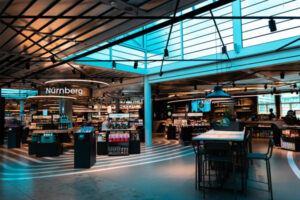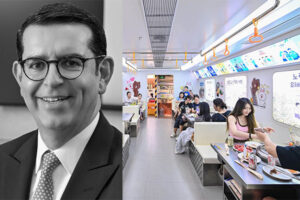By Christoph M. Achammer
The transformation of retail from an industry that endeavored to satisfy its customers’ needs as competently and cost-effectively as possible is currently in full swing. The most consolidated form of retailing, the shopping center industry, has been hit particularly hard.
Dramatic changes, at various levels, have taken place during the first few decades of the 21st century. Classifying customers as clearly identifiable individuals according to origin, purchasing power, and preferences is no longer possible. People are either inclined to buy anything, anywhere, or they are not. This development towards a hybrid customer is accompanied by a clear shift in demographics. In Western societies, the older proportions of the respective populations are steadily increasing, while, at the same time, their disposable income as well as their desire for social integration are on the rise. In the absence of their extended families, this generation is in search of other means of communication, experience, and integration. In the future, conceivable places for such encounters might increasingly include shopping centers. Meanwhile, a new generation of digital natives has emerged, and those individuals have a completely different understanding of ownership. A general Millennial trend involves sharing rather than owning and experiencing rather than consuming products. Despite the enormous progress that has been made in the digital world, I believe that, in the future, there will still be a great opportunity for these experiences to take place in direct exchange wherever suitable.
The rapid development of new technologies suggests that many requirements to satisfy demand, whether for daily bulk goods or previously painstakingly sought-after special products, will no longer necessarily be met via traditional brick-and-mortar retailing. Retail, in particular shopping centers, will increasingly become places of experience, interaction, and unforeseen occurrences. One might counter the ever more perfect digital world with the fascination of the imperfect real world, which is capable of exerting immense attraction with regard to the aforementioned requirements. What does all of this mean for our current shopping center structure?
As one of the major European architecture and engineering firms, which handles between 100,000 and 200,000 sq m of rental area per year, we have seen the following seven developments:
First of all: Clearly, the proportion of new space available at new centers has significantly shifted in favor of refurbishments.
Second of all: Centers counting up to 20,000 sq m of rental area will continue to be successful if they are embedded inside vibrant urban surroundings and enter into dialog with all adjacent areas. The age-old notion that a center is only good if it has a defined entrance, starting from which all customers are guided throughout the center, leaving only after every storefront has been viewed or purchases have been made in every store, no longer applies. Nowadays, such centers have to be able to effectively connect with their respective public surroundings, even when there is a risk that some areas will not be frequented by every visitor. Isolated locations of this size face major challenges and, in many cases, will only be able to continue to fulfill their roles as local supply and neighborhood facilities.
Third of all: Medium-size centers, as defined by the ICSC, have been the hardest hit in our view. In many cases, they are too large to constitute an equally viable urban element and too small to provide the numerous spatial conditions that will be required by future non-retail functions.
Fourth of all: The actual retail areas account for up to 60% of the total area and are supplemented by restaurants, health care facilities, educational facilities, meeting and adventure areas, sports facilities, etc.
Fifth of all: Structures must be designed in such a way that renders them as flexible as possible. At present, 10-plus-5-year leases are fading away. Pop-up stores that only operate for a few days and leases of up to three months have become the new reality. Centers have become more like bustling marketplaces than shopping street replicas.
Sixth of all: Nevertheless, spaces must continuously be developed that establish identity and, more than ever, put people at the center of their attention.
Seventh of all: On the one hand, economic conditions have become increasingly demanding as a result of these developments. On the other hand, consistently low interest rates help, as does the fact that most buildings already exist and re-investments are well below new construction requirements.
With regard to very large centers measuring 70,000 sq m and above, in particular, special opportunities can be seen as they, regardless of their performance to date, generally provide space that allows previously unknown combinations of offerings at very reasonable costs. On the one hand, this enables rapid reaction to the emerging providers that we have seen throughout Europe, some of which involve very space-intensive concepts. On the other hand, critical mass is sufficient enough to integrate, among other things, libraries, schools and medical centers. In addition, we anticipate the successful combination of individual services with large-scale furniture and furnishing offerings, as IKEA, in particular, has proven to be extremely successful in some countries.
However, the primary objective of all of these activities is to create clear and, for the most part, local identities that are capable of supporting various unique and once-in a-lifetime experiences. Design, ambiance, and continuous staging, which, in contrast to the past, is predominantly driven by the users, are of great significance in this respect.
Our work has shown us that the future will hold a particularly great opportunity for large and extremely large structures that are capable of being functionally hybridized and have the structural flexibility to continuously adapt to new challenges at short intervals. Flawless transport infrastructure – both private and public – is a fundamental prerequisite for this. Manageable and reasonable financial conditions will also boost opportunities. Accordingly, this will create considerable chances for projects that already have substantial depreciation periods behind them. In my opinion, all of these challenges will result in significant structural as well as formal changes, which I, personally, look forward to. As a long-standing European Council of Shopping Centers juror, I have noticed that, over the past few years, many of the award-winning and thus the best projects in Europe offer more of the same over extended stretches. The true innovation is imminent and will undoubtedly materialize without the suspension of the qualities and guidelines that have been tried and tested for decades. At the current speed of change, real estate is becoming increasingly mobile, which means that everything simultaneously changes and stays the same.






